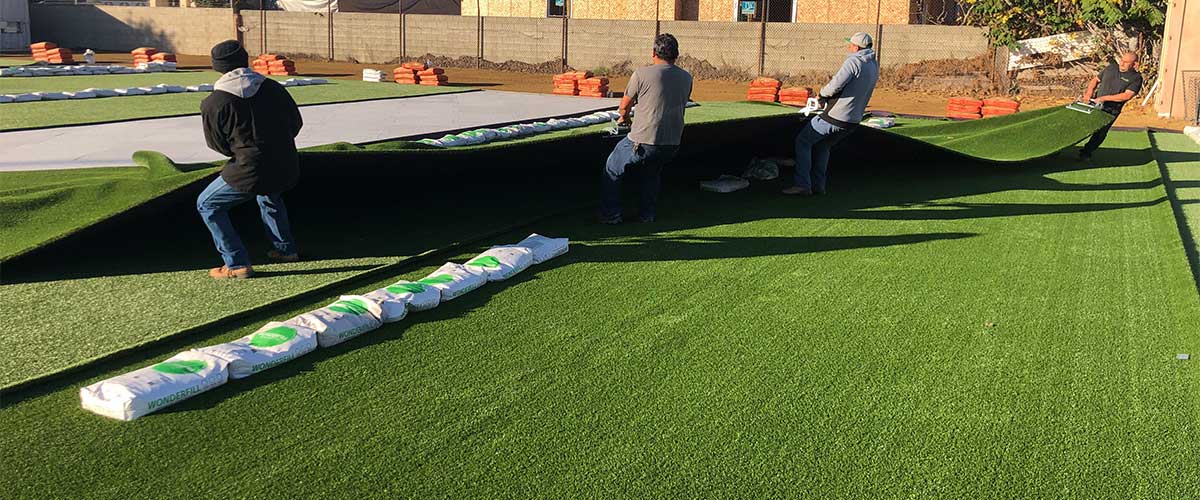Artificial Turf, Turf Installation
The 7 Common Mistakes When Installing Artificial Turf
Artificial turf can be a significant source of beauty and value for your home or business. The first thing most neighbors see is your yard. But an improperly laid lawn can ruin everything.
Whether you are a DIY homeowner or a professional turf installer, make sure to address these common mistakes to ensure your beautiful lawn doesn’t become a major eyesore.
#1 – Not ordering enough (or too much!) turf.
It happens more than you might think. An inspired DIYer orders a roll of fake grass with the hope of beautifying their yard over the weekend, only to find out partway through that they don’t have enough turf!
Besides the hassle of going back for more (or find you’ve spent too much), later batches of the same type and product can have a slightly different hue, making your artificial lawn look patched.
#2 – Not planning for poor drainage.
As you begin excavating and planning your landscape project, ensure it is graded to allow proper drainage. Puddles and pools of water will form if the turf is not installed with an even surface
#3 – Forgetting a weed barrier.
One of the benefits of an artificial lawn is the almost complete lack of yard work you’ll need to do to keep your yard beautiful. Properly installing a weed membrane under your synthetic lawn will ensure that no weed growth breaks through on your new lawn.
#4 – Bumpy or uneven surface.
Artificial turf installation requires a sub-base of packed rock, porous enough to allow for drainage, and a layer of crushed sand or granite called the “laying course” to create an even and comfortable walking surface. Choosing the correct base material and carefully reviewing the entire surface with a compactor is essential. DIY installation can still look professional if you make sure your base is compacted graded, even before adding your synthetic turf.
#5 – Laying the wrong angle.
One of the common mistakes people make when installing artificial turf is not accounting for the direction and angle of the grass. It’s not something present in natural grass, but all fake grass has a pile direction. Each fiber is manufactured with a slight angle in the same direction. In many situations, like a backyard install, you want your pile direction to face the house so that you look into the grass’s angle. This gives a fuller and more natural look. It’s also crucial that multiple pieces of synthetic grass are installed on the same angle so that the seams remain invisible.
#6 – Your seams are showing.
Nothing ruins the allure of your beautifully manicured lawn more than an obvious seam running through the middle. The S-seam method is one that we use on every installation. We use a tool designed specifically for cutting in artificial turf seams with a 9′′ radius curve. This allows the seam to overlap, greatly reducing the visibility of the seam. We then secure the seams with seaming tape, artificial grass adhesive, and 40D 5” nails every 4-6”.
#7 – Choosing the wrong infill.
There are two primary functions of synthetic turf infill. The first is to assist in anchoring your artificial turf by adding weight to the backing. This is essential in preventing ripples from developing during warm / cool temperature fluctuations. The other function turf infill serves is to add ballast and to assist in keeping the turf fibers standing up. In sports fields and commercial playground applications, a high amount of infill (typically crumb rubber) is used to add impact attenuation for falls or tackles.
There are several options based on your project and use. Anti-microbial infill for use in playgrounds and areas with pets, silica sand for areas with lighter foot traffic, and crumb rubber found in higher impact zones like sports fields.
Intergriturf has your back! Make sure to check out all our products and other articles to answer more questions and get you on the right track to installing the perfect lawn for any location.
To read more about turf installation, check out our post on artificial turf installation tips.

